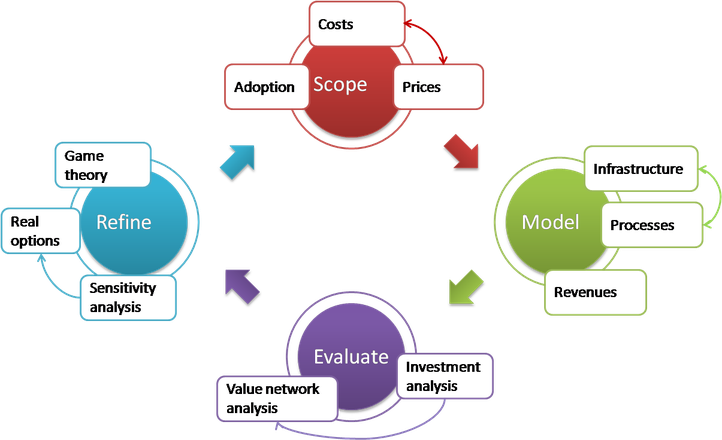Techno-economics
Techno-economic research applies a multi-disciplinary approach to provide evidence-based responses to the socio-economic impact of technological innovations and policy challenges. It involves a portfolio of qualitative and quantitative methodologies that take into account the uncertainty caused by the involvement of multiple stakeholders, the dynamicity of uptake and pricing, as well as boundary conditions, such as specific policy or regulation and geographic and demographic characteristics.
Subdomains include cost modelling (infrastructure, equipment and operational cost) for network or service deployments, cost allocation (relating cost categories to specific services), investment analysis (supporting technology choices, network migration decisions, etc.), business modeling for a wide range of actors (equipment vendors, operators, service providers, public bodies) and value network analysis (focusing on the interrelations between the actors). Further refinement is added by considering the impact of uncertainty and competition using sensitivity analysis, game theory and real options.
Important techno-economic research questions pop-up in different application domains: What are best practices for successful FTTH deployments? What are appropriate technology choices in a smart city context? How to optimally rollout e-health services for all actors? What is a sustainable sensor solution in a manufacturing setting? etc.
Staff
Sofie Verbrugge, Didier Colle
Researchers
Marlies Van der Wee, Bram Naudts, Frederic Vannieuwenborg, Jonathan Spruytte
Projects
- RECODIS, Resilient Communication Services Protecting End-user Applications from Disaster-based Failures.
- ICON MoniCow, Monitoring and localisation of animals: focus on Cows.
- FP7 UNIFY, Unifying Cloud and Carrier Networks
- ICON HIPS, Innovation through optimized an integrated patient and supply flows in hospitals
- ICON MECaNO, Media Contribution Network Optimization
- ICON TERRAIN, Techno-economic research for future access infrastructure networks
- FP7 OASE, Optical Access Seamless Evolution
- ProMoBed, Hospital Capacity Model
Key publications
- Naudts, B., Tavernier, W., Verbrugge, S., Colle, D., & Pickavet, M. (2016). Deploying SDN and NFV at the speed of innovation: Toward a new bond between standards development organizations, industry fora, and open-source software projects. IEEE Communications Magazine, 54(3), 46-53.
- Vannieuwenborg, F. Van Der Auwermeulen, T., Van Ooteghem, J., Jacobs, A., Verbrugge, S. and Colle, D. (2016) Bringing smart home care platforms to the market. Inform Health Soc Care. 2016 Aug 26:1-25. [Epub ahead of print]
- Van der Wee, M., Verbrugge, S., Tahon, M., Colle, D., & Pickavet, M. (2014). Evaluation of the techno-economic viability of point-to-point dark fiber access infrastructure in Europe. Journal of Optical Communications and Networking,6(3), 238-249.
- Tahon, M., Verbrugge, S., Willis, P. J., Botham, P., Colle, D., Pickavet, M., & Demeester, P. (2014). Real options in telecom infrastructure projects—A tutorial. IEEE Communications Surveys & Tutorials, 16(2), 1157-1173.
- Casier, K., Lannoo, B., Van Ooteghem, J., Verbrugge, S., Colle, D., Pickavet, M., & Demeester, P. (2009). Game-theoretic optimization of a fiber-to-the-home municipality network rollout. Journal of Optical Communications and Networking, 1(1), 30-42.
- Verbrugge, S., Colle, D., Pickavet, M., Demeester, P., Pasqualini, S., Iselt, A., Kirstadter, A., et al. (2006). Methodology and input availability parameters for calculating OpEx and CapEx costs for realistic network scenarios. JOURNAL OF OPTICAL NETWORKING, 5(6), 509–520.
- Verbrugge, S., Pasqualini, S., Westphal, F.-J., Jäger, M., Iselt, A., Kirstädter, A., Chahine, R., et al. (2005). Modeling operational expenditures for telecom operators. In A. Pattavina (Ed.), 2005 Conference on optical network design and modelling, proceedings (pp. 455–466). Presented at the 9th Conference on Optical Network Design and Modelling (ONDM 2005) : Towards the broadband for all era, New York, NY, USA: IEEE.

